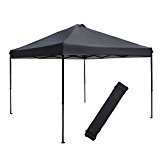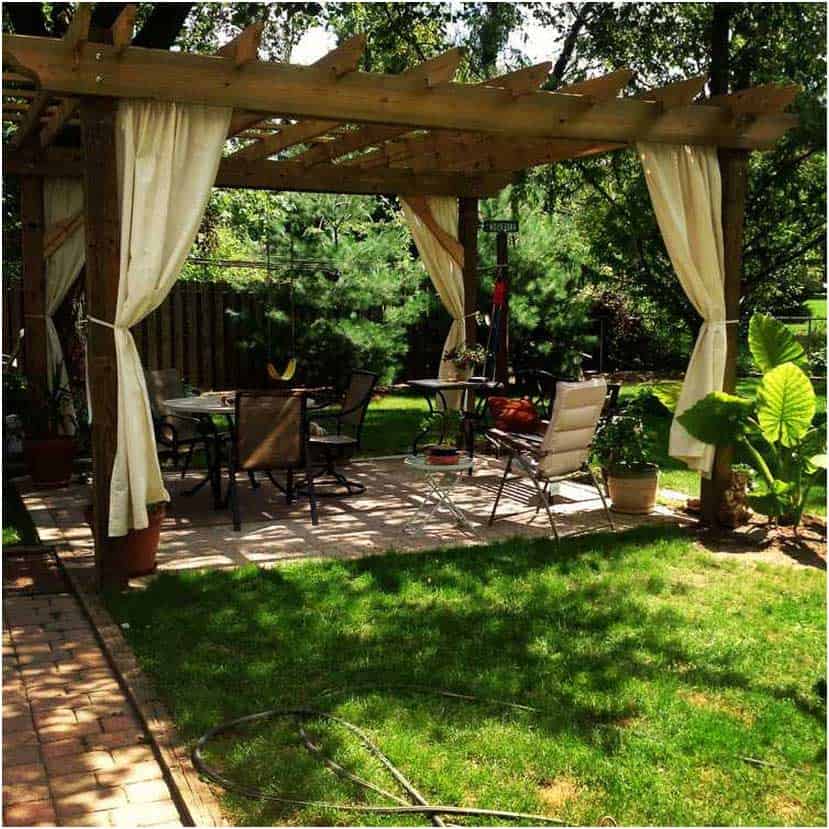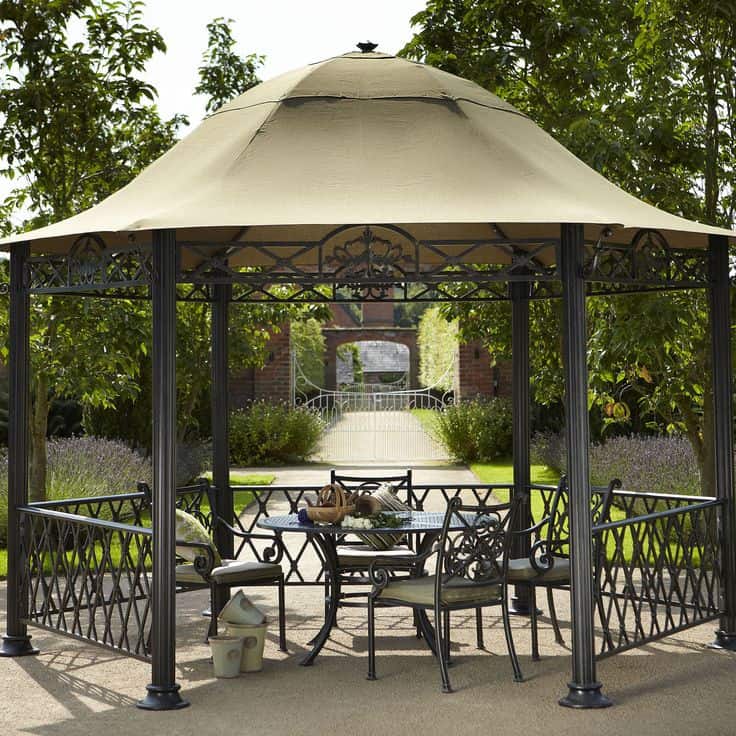What is a Gazebo?
Top Gutter Guard is reader-supported. When you buy through links on our site, we may earn an affiliate commission.
The Only Article About Gazebos, Pergolas, Arbors and Canopies that You Must Read!
If you’re feeling confused with the terms gazebo, pergola, arbor and canopy, you’ll be happy you found this website! We have prepared this article as a simple and concise resource to help you understand the similarities and differences between these structures, as well as their ideal usage.
We start by clearly explaining the difference between a gazebo and a pergola, an arbor and a canopy – so you can tell these structures apart easily. From there, we’ll focus on the gazebo to tell you a little of its historical uses, where you can buy them right now, and some important considerations you should keep in mind while looking to add this kind of outdoor furnishing to your home. For the sake of clarity, we’ll wrap up this presentation by look at the contrasts arbor vs pergola and gazebo vs canopy, to point out in which situations each of these structures will be your ideal choice.
Read on and you’ll see this is actually a simple matter when clearly explained. You’ll also likely notice that most people are using these terms interchangeably, and often more loosely than they might realize: gazebos, pergolas, arbors and canopies are, after all, distinctively different structures, each best suited for a different purpose.
Full overview of all you need to know about gazebos & company
When we talk about gazebos, pergolas, arbors or canopies, we always speak of relatively small structures to be typically placed in a house garden with the purpose of creating a sheltered area outdoors. They can be simple or intricate, permanent or semi-permanent, according to taste and budget. Whatever your choice maybe, you should make sure to be clear on the terms you’re using and what they mean.
The difference between these words lies in the exact specifications of each structure, particularly the size and building materials. It’s worth noting that you’re not exactly looking at choosing either structure over the other, since in many cases they can be complementary. Many people use gazebos and pergolas together to great effect, as you’ll see below. Here’s a quick rundown on the specific meaning of each term:
Gazebo: a roundish, open garden structure with a roof similar to a house; built to last with materials such as wood and steel. A gazebo can be as modest or as intricate as the owner so envisions; in rich estates it’s not uncommon to gazebos so large they can easily host a wedding or other big celebrations. Often that is exactly what large scale gazebos are meant for, in modern times.

Pergola: a covered walkway, often featuring sheltered seating areas; built to last with permanent materials like wood, steel and even concrete. The main difference between a pergola and a gazebo is essentially the shape: gazebos are always semi-rounded in shape, whereas pergolas are straight, often narrow and long walkways. They can otherwise look very much similar in terms of scale and building materials, so it’s not uncommon to see a combination of both.

Arbor: think of this as a mini-gazebo; it’s basically a bench surrounded by a (sometimes makeshift) roof; it often relies on lattice panels to create a shaded area; usually built to last, but not as sturdily as a gazebo where the same kind of roofing is used as in an actual house. Typically an arbor doesn’t have a proper roof, but simply an open structure mean to create shading.

Canopy: a canopy can be simply conceived as a modern interpretation of the gazebo; unlike its predecessor, canopies are meant to be temporary structures favoring convenience over durability. Canopies made of lightweight materials and typically easy to assemble and put away – just like a tent, although usually featuring much thicker supports for added stability. You may notice many stores these days are referring to their cheaper gazebos as canopies, a misleading use of the language that you should watch out for.
What exactly is a gazebo?
Gazebos are also known as summer houses, tea houses, pergolas, pagodas, kiosks, or pavilions. The simplest way to think of a gazebo is like a small, rounding garden house with no walls. Its exact shape and footprint may differ, but a gazebo is always roughly circular and always features a proper roof that is often similar to the nearby house. You should be familiar with this kind of structure from pictures of opulent old country houses, the kind you see in paintings and period films, where noble people often gathered for tea and companionship.
For the sake of accuracy, it’s worth pointing out the exact prerequisites that should be in order before a structure can be rightfully called a gazebo:
Gazebos are open garden structures, often hexagonal or even hexagonal in shape. They are also, by definition, free-standing structures which are sheltered with a roof very similar to what you’d expect to see in a regular house – except there are no walls involved. They must always have a proper roof that will ensure a long lasting structure. When standing before a gazebo, you’re looking at no walls covering a roundish structure that is built using permanent materials such as metal and wood.
In short, gazebos are something like tiny, round, one-room houses with no walls and a seated area all around the inner circle of the structure. As you’re going to learn in the next section, gazebos serve both a practical purpose as well as for exhibition of status.
What are gazebos used for?
Once upon a time, gazebos were regarded both as sanctuaries and signs of opulence. It was very common for large estates to feature impressive gazebos therein, where the house lords would spend time in secluded meditation or otherwise welcome their guests for private conversations in a pleasing outdoors setting. Some of these gazebos of old where extremely intricate and highly ornamented structures that spared no efforts to convey a sense of wealthy reverence. In short, they were both used for leisure and for affirmation of status, and even today these structures will surely improve the value of a property.
It was once very common to find large gazebos not only next to the wealthier houses, but also in the centre of most towns, where they would be used both for public gatherings and to sit the audience during entertaining shows. In many smaller towns across the world, you may still come across these historical gazebos which are often well preserved and still being used for the exact same purpose of sheltering large groups during public events.
Where to best buy your gazebo
If you’re looking to buy a gazebo that will both add decorative value to your garden as well as creating an enjoyable area for sitting down in conversation with your guests, Amazon may be an obvious choice to start looking. There’s no need to make arguments for the quality and reliability of this supplier, which have surely heard about by now. Amazon takes pride in offering outstanding customer service and high reliability in deliveries, which are indeed positive qualities when looking to purchase such bulky and expensive materials as a gazebo.
A quick search on Amazon will reveal a huge offering with hundreds of search results just for the term “gazebo”. You’ll find some interesting prices ranging from two digits to low three digits, but do take notice: these lower prices are generally nothing but sophisticated canopies… which is something like saying they’re the tent version of a real gazebo. Some of those models may look quite attractive, but keep in mind that for this price range you’re looking at structures made with semi-permanent materials that will likely lose their charm within a short few years.
If you want a real gazebo that will add value to your property and improve the usability of your garden, you should be prepared to spend anything from middle three digits to low four digits.
Try searching for “wood gazebo” at Amazon and you’ll come across some interesting structures at very reasonable price. You may even find a proper looking gazebo in the low hundreds of pounds, but thinking about the costs of material alone we would not vouch for such products since such pricing seems unrealistic. Remember that in gazebos as in life, you often get what you pay for!
Looking at available gazebo sizes
When you start looking at the available options, soon you realize how there are gazebos available in just about every size. From modest backyard gazebos big enough to sit two or three people at most, to luxurious and intricate gazebos which can hold massive gatherings and are bigger in size than many houses.
There are so many products and designs to choose from, that it can be overwhelming. We recommend you to start by looking at your available garden space and deciding what’s the ideal footprint area for your gazebo, so you can then focus on finding a structure matching that size specification. From there, it’s a matter at searching for a design within your budget in the required size that neatly matches your personal preference, as well as your house.
What is a pergola and when should you get one?

Arbor vs pergola: understanding best uses
You may want to check back on the overview section at the beginning of this article, to improve your grasp on the exact similarities and differences between a pergola and an arbor: remember, the former is a sheltered passageway, while the latter is merely a shaded bench.
Depending on the specific layout of your garden, it may not be unreasonable to consider combining both structures – by building a pergola that leads to an arbor deeper into your garden, for example.
If you have limited space in your garden for a free standing structure, then getting a simple arbor may be your best option. If your garden layout features a longer and wider area, that might be best suited to build a comfortable and spacious argola with plenty of sheltered seats underneath.
Gazebo vs canopy: which suits you best?
Canopies are essentially makeshift structures with a similar purpose to gazebos. The main difference is how the latter are meant to be a permanent outdoor furnishings, whereas canopies are temporary structures that are not intended to stand the test of time – but rather to be convenient and simple to set up when needed and to allow convenient disassembling when past their occasional utility.
Some people do use canopies in a semi-permanent fashion, by simply letting these structures stand idle until the plastics start looking ugly and worn out (which often won’t take even four seasons, depending on your local weather). We advise you not to follow this casual approach; if you want an efficient structure that will look pleasing to the eye and create a comfortable setting for having an afternoon tea with your guests in your backyard, you might as well go all out by getting a proper gazebo.
Depending on the models you choose and where you buy them from, you may realize the cost of getting a good looking gazebo that will look good for decades won’t be too unreasonable compared to the cost of a temporary (yet movable) canopy that will likely be weather-worn and suitable for trash only after a year or two.
Finally, do keep in mind how the expenses from getting a nice gazebo look more reasonable when you think long term, and consider how having a good structure for leisure and recreating in the garden will only increase the value of your property.


